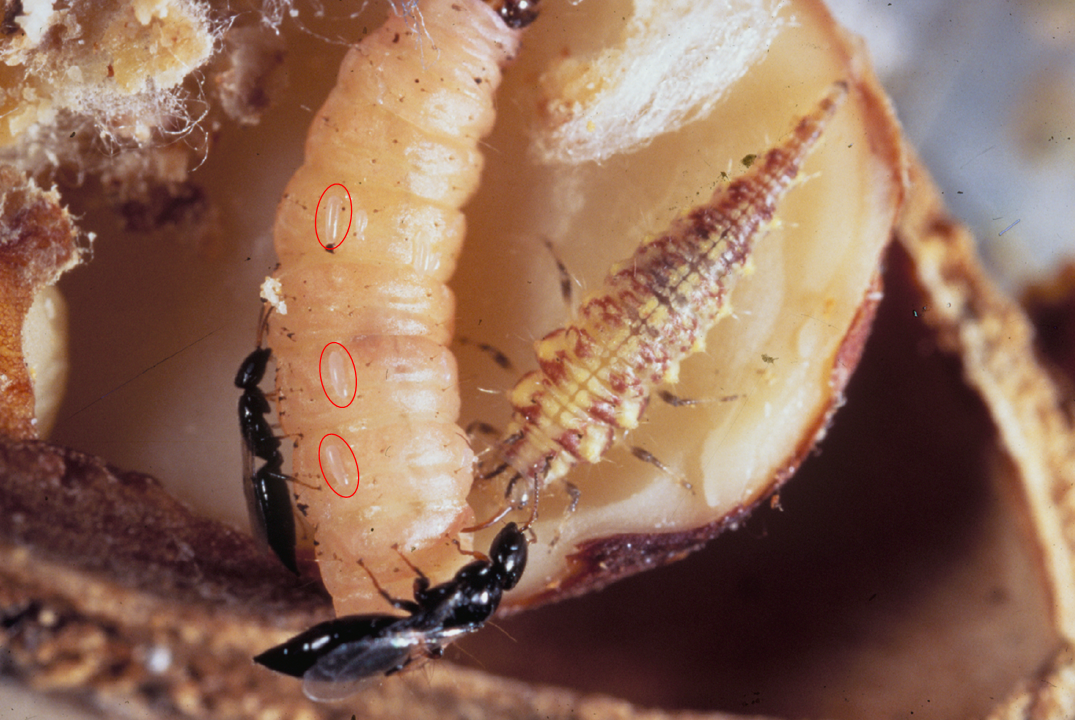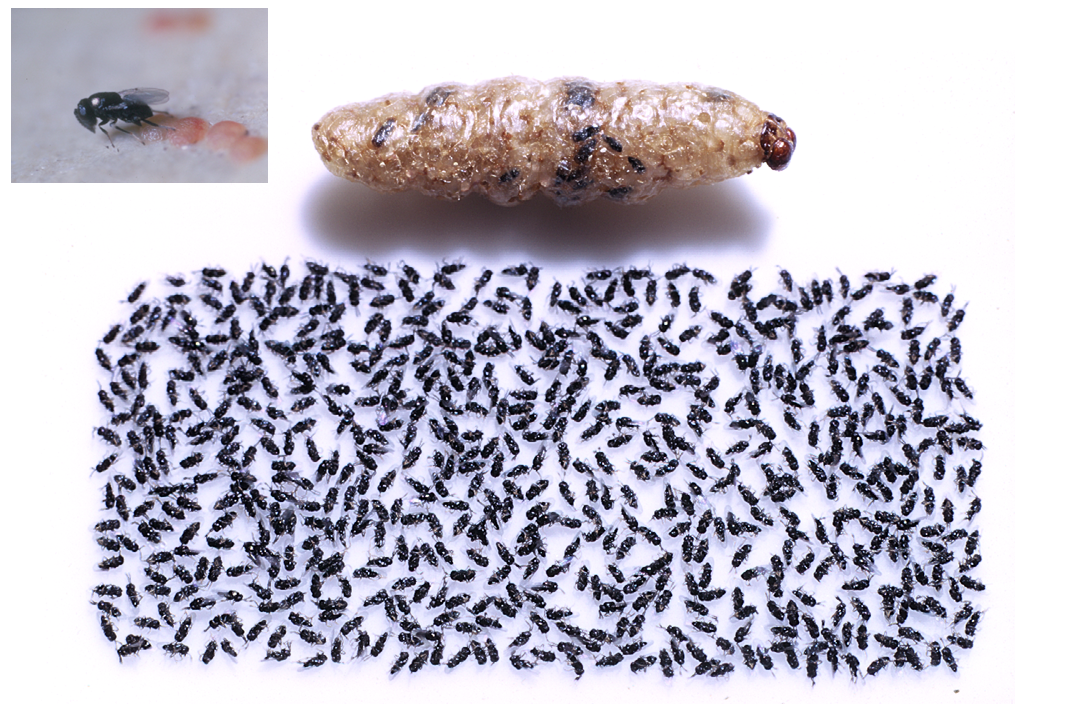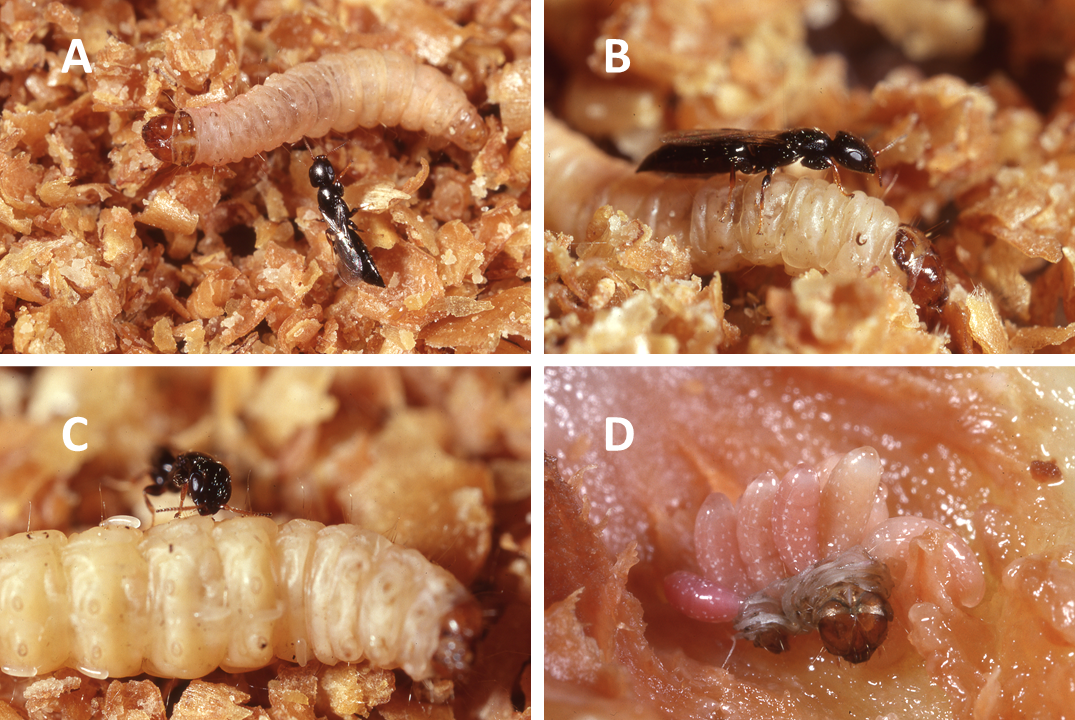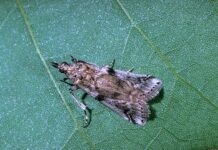
University of California researchers have been evaluating the role of biological control of navel orangeworm (NOW) in California for nearly five decades. This includes efforts since the 1970s to document the impacts of native predators and parasitoids on NOW control, and to find new parasitoid species to import and introduce. In general, biological control for NOW has had a secondary role in IPM programs, with cultural and chemical controls, including mating disruption, taking the lead. However, as broad-spectrum insecticides become more and more obsolete within almond and walnut production systems, and as producers of all nut crops embrace reduced-risk technologies like mating disruption, opportunities for biological control to play a role in integrated pest management programs are on the rise.
Early Research
Two UC researchers were key in the initial development of NOW biological control in the 1970s: Dr. Leo Caltagirone at UC Berkeley and, later, Dr. Fred Legner at UC Riverside. Both Caltagirone and Legner worked closely with UCCE farm advisors and staff and students at the former Division/Center of Biological Control (UC Berkeley) and Department/Division of Biological Control (UC Riverside).
Caltagirone’s initial efforts were to document the natural enemies already present in California that attacked NOW and the closely related carob moth (Ectomyelois ceratoniae). The egg parasitoid Trichogramma californicum was found as well as a number of larval parasitoids including the bethylid Parasierola breviceps, the braconids Habrobracon hebetor and Phanerotoma, the ichneumonids Venturia canescens and Mesostenus gracilis, and the chalcidid Spilochalcis leptis.
Caltagirone also documented a number of predators, including green (Figure 1) and brown lacewings and lady beetles attacking the moth’s larvae, and predaceous mites and the mirids Phytocoris relativus and P. californicus attacking the moth’s eggs. Unfortunately, all of these parasitoids and predators attacked a wide range of prey, and none were specialized enough on NOW to seriously drive down populations. As such, NOW persisted as a pest, and a classical biological control program was initiated with the goal of discovering more specialized natural enemies that had more closely coevolved with this pest in its native range, and therefore better adapted to naturally maintain NOW at densities below economic injury thresholds.
Caltagirone reported that NOW seems to be native to Central and South America; his surveys in the late 1960s to 1970s found it widespread in northern Mexico, and NOW was reported as far south as Peru, central Argentina and Uruguay. Today, it has extended its distribution to the southern U.S., across the south from California to the east coast and as far north as North Carolina. The first damaging infestations in almond and walnut crops were encountered in the 1950s, but through the 1960s, damage was relatively mild, typically <2%, until the late 1970s when damage of untreated populations was ~10% of Nonpareil almonds.
Caltagirone focused his exploration efforts in southern Texas and northern Mexico, where he discovered the encyrtid Copidosoma (=Pentalitomastix) plethorica, which had never before been described (Figure 2). This parasitoid has a very interesting biology in that the adult wasp puts an egg into the NOW egg, but the parasitoids emerge from the last stage of the moth larvae; in fact, hundreds of parasitoids emerge from a singly parasitized NOW larva. This wasp is ‘polyembryonic’ where the parasitoid egg hatches and forms a ‘polygerm’ of genetically identical embryos from a single egg through clonal division, basically like identical twins but hundreds of them. Following this discovery, in the 1960s and 1970s, the UC Berkeley laboratory produced millions of these wasps and released them throughout the Sacramento and San Joaquin valleys. The parasitoid established in California and is still found today, but is more common in the Sacramento Valley than in the San Joaquin Valley.

Shortly thereafter, Dr. Fred Legner focused his efforts to find a parasitoid in Uruguay and central Argentina as well as supplemental collections in southern Texas. Working with regional entomologists, he discovered another previously unidentified parasitoid, the bethylid Goniozus legneri (named after Legner) in Uruguay, and also imported the closely related G. emigratus from Texas. These bethylids also have a unique biology as described in Figure 3. Goniozus legneri is perhaps the most commonly found NOW parasitoid in California today.
Other natural enemies imported during the 1970s and 1980s include the egg parasitoid Trichogammatoidea annulata from Argentina, which in augmentation studies reached parasitism levels of 20%. The larval parasitoids Phanerotoma flavitestacea from Israel and Diadigma sp. from Australia were also imported and released, and while they reached parasitism levels up to 25% during the release trials, they did not overwinter well in California and are rarely found attacking NOW today.
Evolving Biologies
While these natural enemies and others are still working in California’s tree nut crops, they still do not singularly or collectively provide control levels acceptable to most growers. Part of the issue is their biologies that may have evolved to satisfy their own survival rather than the control levels needed by modern growers, especially in the face of strict aflatoxin regulations. For example, the two most important imported natural enemies, C. plethorica and G. legneri, have biologies that allow them to make the most use out of a single host rather than search and kill many hosts.
Copidosoma plethorica is polyembryonic, so finding and parasitizing a single moth egg can lead to up to 800 offspring, but it is still only killing one moth egg. This species is easy to rear in the laboratory, but in the orchard, it is dependent on the ready presence of moth eggs to continue to reproduce, and in periods without eggs present or at low host densities when the adult wasps cannot find an egg, their numbers decrease.
Similarly, G. legneri puts many eggs on a single host larva, but the adult wasp has a behavior called ‘brood guarding’ where she will not attack and deposit eggs on a host and then go out and search for an anther host; rather, she will stay by her eggs and protect them from other G. legneri (that will kill her eggs and deposit their eggs on a host – or fight off other predators like green lacewings as seen in Figure 3.) For this reason, G. legneri does well when the NOW density is high, say 20% nut infestation, and you might have 20% to 40% parasitism levels in October after harvest. This is because the high pest population presents a target-rich environment where a female G. legneri can find and guard many NOW that are close together, but as the pest density lowers, parasitism levels seem to drop as well, and at current thresholds of <2%, it is often difficult to find a G. legneri in the orchard. Legner had suggested one practice might be to leave some nuts on the tree during the winter, but research in the 1990s showed that this leads to more NOW than G. legneri because the parasitoid overwinters as an adult and, as a result, does not need to have the mummy left in the orchard.

As mentioned, if you have NOW in your orchard, then these natural enemies are probably in your orchard at some level. Researchers are currently looking at ways to improve sustainable NOW control through manipulating ground cover management that may protect pollinators and enhance these natural enemy populations. While cover crops can be useful in some cropping systems, the addition of ground covers in tree nut orchards may not necessarily address the key bottlenecks currently limiting the impacts of natural enemies on NOW.
Surprisingly, one of the most overlooked of these predators, the common resident green and brown lacewings, might be the most stable and persistent of the resident and imported natural enemies. The green lacewing is commonly one of the more resistant natural enemies to different pesticides, and because they are generalist they are often found in the orchard at low or high NOW densities. Moreover, reported populations of NOW in Argentina and Chile never seem to reach damaging populations, and this does open the possibility to some other control agent out there that has yet to be discovered.
In California tree nuts, a great deal of effort has been made to identify and evaluate potential biological control agents for NOW, but up to this point, the role of biocontrol has been secondary to the use of winter sanitation, insecticides, timely harvest and mating disruption as the primary components of an IPM program. However, as growers shift away from broad-spectrum insecticides and embrace reduced-risk, selective chemical control programs for NOW, husk fly, scale, aphid and mealybug pests, it is anticipated that biological control organisms will have increased opportunities to become established and assist with NOW management programs. Information regarding the short- and long-term impacts of chemical control pests for almond, pistachio and walnut pests can be found within the ‘Relative Toxicities of Pesticides to Natural Enemies and Honey Bees’ tables in the corresponding UC IPM Pest Management Guidelines for each commodity at ucipm.ucanr.edu/agriculture.











